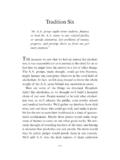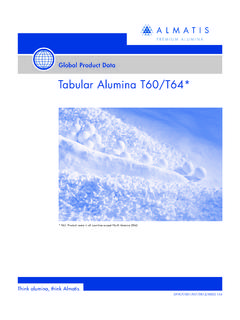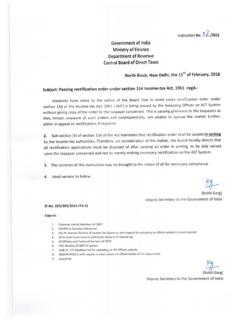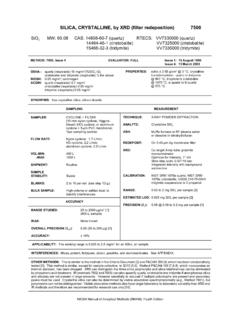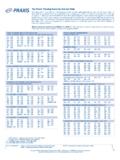Transcription of HYDROCARBONS, AROMATIC 1501
1 NIOSH Manual of Analytical Methods (NMAM), Fourth EditionHYDROCARBONS, AROMATIC1501 FORMULA: Table 1 MW: Table 1 CAS: Table 1 RTECS: Table 1 METHOD: 1501, Issue 3 EVALUATION: FullIssue 1:15 August 1990 Issue 3:15 March 2003 OSHA : Table 2 NIOSH: Table 2 ACGIH: Table 2 PROPERTIES:Table 1 SYNONYMS: Group A: benzene toluene ethylbenzene o-xylenem-xylene p-xylene(Synonyms in Table 1) Group B: cumene p-tert-butyltoluene "-methylstyrene $-methylstyrene styreneSAMPLINGMEASUREMENTSAMPLER:SOLID SORBENT TUBE(coconut shell charcoal, 100 mg/50 mg)FLOW RATE:Table 3 VOL-MIN:Table 3 -MAX:Table 3 SHIPMENT:RoutineSAMPLESTABILITY:30 days @ 5 CBLANKS:10% of samplesTECHNIQUE:GAS CHROMATOGRAPHY, FIDANALYTE:Hydrocarbons listed aboveDESORPTION:1 mL CS2, stand 30 min with agitationINJECTION VOLUME:1 L (Group A: split 5:1; Group B: split 1:1)TEMPERATURE -INJECTION:250 C -DETECTOR:300 C -COLUMN:Group A: 40 C (10 min) to 230 C(10 C/min)Group B: 35 C (8 min) to 225 C(10 C/min) CARRIER GAS:He @ mL/minCOLUMN:Capillary, fused silicaGroup A: 30m x ID; 1- m film100% PEG or equivalentGroup B: 30m x ID; 3- m filmcrossbonded 35% diphenyl 65%dimethyl polysiloxane or equivalentCALIBRATION:Solutions of analytes in CS2 RANGE:Table 4 ESTIMATED LOD:Table 4 PRECISION ( r):Table 4 ACCURACYRANGE STUDIED: Table 3 BIAS: Table 3 OVERALL PRECISION ( rT): Table 3 ACCURACY: Table 3 APPLICABILITY: This method is for peak, ceiling, and TWA determinations of AROMATIC hydrocarbons.
2 Interactions betweenanalytes may reduce breakthrough volumes and affect desorption efficiencies. Naphthalene, originally validated in S292 [4],failed to meet acceptable desorption efficiency recovery and storage stability criteria at the levels evaluated in this study. However, the application of this method to naphthalene levels at or near the REL/PEL continues to meet acceptable recoverycriteria. Styrene failed to meet acceptable recovery criteria at the two lowest levels evaluated in this study (highest level tomeet the criteria was 181 g/sample).INTERFERENCES: Under conditions of high humidity, the breakthrough volumes may be reduced. Other volatile organiccompounds such as alcohols, ketones, ethers, and halogenated hydrocarbons are potential analytical interferences. OTHER METHODS: This method updates NMAM 1501 issued on August 15, 1994 [1] which was based upon P&CAM 127(benzene, styrene, toluene, and xylene) [2]; S22 (p-tert-butyltoluene) [3]; S23 (cumene) [3]; S29 (ethylbenzene) [3] ; S26("-methylstyrene) [3]; S30 (styrene); S311 (benzene) [4]; S343 (toluene) [4]; and S318 (xylenes) [4].
3 HYDROCARBONS, AROMATIC : METHOD 1501, Issue 3, dated 15 March 2003 - page 2 of 7 NIOSH Manual of Analytical Methods (NMAM), Fourth disulfide*, low benzene, chromatographic , reagent , prepurified and , prepurified and , prepurified and filtered. * See SPECIAL : glass tube, 7 cm long, 6-mm OD, 4-mm ID, flame-sealed ends, containing two sections of activated coconut shell charcoal (front = 100 mg, back = 50 mg) separated by a 2-mm urethane foam plug. A silylated glass wool plug precedes the front section and a 3-mm urethane foam plug follows the back section. Tubes are commercially sampling pump, to L/min (Table 3), with flexible connecting chromatograph, FID, integrator, and columns (page 1501-1). vials, glass, mL, with PTFE-lined , 1-mL, and pipet , 10- L, 25- L, and 250- flasks, PRECAUTIONS: Carbon disulfide is toxic and extremely flammable (flash point = -30 C),benzene is a suspect carcinogen. Prepare standards and samples in a well ventilated hood.
4 SAMPLING: each personal sampling pump with a representative sampler in line. the ends of the sampler immediately before sampling. Attach sampler to personal sampling pumpwith flexible tubing. at an accurately known flow rate between and L/min for a total sample size as shownin Table 3. the samplers with plastic (not rubber) caps and pack securely for PREPARATION: the front and back sorbent sections of the sampler tube in separate vials. Include the glass woolplug in the vial along with the front sorbent section. mL eluent to each vial. Attach crimp cap to each vial immediately. to stand at least 30 min with occasional AND QUALITY CONTROL: daily with at least six working standards from below the LOD to 10 times the LOQ. If necessary,additional standards may be added to extend the calibration curve. known amounts of analytes to carbon disulfide solvent in 10-mL volumetric flasks and dilute tothe mark. Prepare additional standards by serial dilution in 10-mL volumetric together with samples and blanks (steps 11 through 12).
5 Calibration graph (peak area of analyte vs. g analyte per sample).HYDROCARBONS, AROMATIC : METHOD 1501, Issue 3, dated 15 March 2003 - page 3 of 7 NIOSH Manual of Analytical Methods (NMAM), Fourth Edition desorption efficiency (DE) at least once for each batch of charcoal used for sampling in thecalibration range (step 8). three tubes at each of five levels plus three media a known amount of DE stock solution (5 to 25 L) directly onto front sorbent section of eachcharcoal tube with a microliter the tubes to air equilibrate for several minutes, then cap the ends of each tube and allow to (steps 5 through 7) and analyze together with standards and blanks (steps 11 and 12). a graph of DE vs. g analyte a minimum of three quality control blind spikes and three analyst spikes to insure that thecalibration graph and DE graph are in gas chromatograph according to manufacturer's recommendations and to conditions given on page1501-1.
6 Inject a 1- L sample aliquot manually using the solvent flush technique or with an :If peak area is above the linear range of the working standards, dilute with solvent, reanalyze,and apply the appropriate dilution factor in the calculations. Analyte Approximate Retention Time (min)benzenea o-xylenea "-methylstyreneb $-methylstyreneb Separation achieved using a 30-m Stabilwax fused silica capillary Separation achieved using a 30-m Rtx-35 fused silica capillary peak the mass, g (corrected for DE) of analyte found in the sample front (Wf) and back (Wb)sorbent sections, and in the average media blank front (Bf) and back (Bb) sorbent :If Wb > Wf/10, report breakthrough and possible sample concentration, C, of analyte in the air volume sampled, V (L):NOTE: g/L = mg/m3 HYDROCARBONS, AROMATIC : METHOD 1501, Issue 3, dated 15 March 2003 - page 4 of 7 NIOSH Manual of Analytical Methods (NMAM), Fourth EditionEVALUATION OF METHOD:The desorption efficiency, at levels ranging from 5 times the LOQ to the REL, was determined for eachanalyte by spiking known amounts (in CS2) on coconut shell charcoal tubes.
7 Both groups of analytes (Aand B) were spiked together on the charcoal sorbent tubes. All analytes, with the exception of styrene andnaphthalene, exhibited acceptable desorption efficiency recovery results at all five levels evaluated. Styrenefailed to meet the 75% recovery criteria at the g and g levels. Naphthalene failed to meet the 75%criteria at all levels evaluated ranging from g to g. Each analyte, at a level approximately REL/PEL, was evaluated for its storage stability @ 5 C after 7,14, and 30 days. All analytes, with the exception of naphthalene, had acceptable recoveries after 30 : [1]NIOSH [1984]. Hydrocarbons, AROMATIC : Method 1501. In: Eller PM, ed. NIOSH Manual of AnalyticalMethods. 4th rev. ed. Cincinnati, OH: Department of Health and Human Services, Public HealthService, Centers for Disease Control, National Institute for Occupational Safety and Health, DHHS(NIOSH) Publication No. 94-113. [2] NIOSH [1977].
8 NIOSH Manual of Analytical Methods, 2nd. ed., V. 1, P&CAM 127, Department ofHealth, Education, and Welfare, Publ. (NIOSH) 77-157-A. [3]Ibid, V. 2, S22, S23, S25, S26, S29, S30, Department of Health, Education, and Welfare, Publ.(NIOSH) 77-157-B (1977). [4]Ibid, V. 3, S292, S311, S318, S343, Department of Health, Education, and Welfare, Publ. (NIOSH)77-157-C (1977). [5]NIOSH [1977]. Documentation of the NIOSH Validation Tests, S22, S23, S25, S26, S29, S30, S292,S311, S318, S343, Department of Health, Education, and Welfare; Publ. (NIOSH) WRITTEN BY: Stephanie M. Pendergrass, NIOSH/DARTHYDROCARBONS, AROMATIC : METHOD 1501, Issue 3, dated 15 March 2003 - page 5 of 7 NIOSH Manual of Analytical Methods (NMAM), Fourth EditionTABLE 1. SYNONYMS, FORMULA, MOLECULAR WEIGHT, PROPERTIES Name/SynonymsEmpiricalFormulaMolecularWe ightBoiling Point(oC)Vapor Pressure@ 25 oC(mm Hg)(kPa)Density@ 20 oC(g/mL)benzeneCAS #71-43-2 RTECS #98-51-1 RTECS #98-82-8 RTECS #100-41-4 RTECS "-methylstyreneCAS #98-83-9 RTECS WL5075300isopropenylbenzene(1-methylethe nyl) $-methylstyreneCAS #873-66-5 RTECS #108-88-3 RTECS #1330-20-7 RTECS ZE2100000dimethylbenzene (p-xylene)C8H10(ortho)(meta)(para) #100-42-5 RTECS , AROMATIC : METHOD 1501, Issue 3, dated 15 March 2003 - page 6 of 7 NIOSH Manual of Analytical Methods (NMAM), Fourth EditionTABLE 2.
9 PERMISSIBLE EXPOSURE LIMITS, PPM NIOSHACGIHS ubstanceOSHATWATWACSTELTLVSTELmg/m3per (skin)50 (skin)50 (skin) " $ (skin) (skin) Potential carcinogenb Suspect carcinogenc Group I PesticideTABLE FLOWRATEa, VOLUME, CAPACITY, RANGE, OVERALL BIAS AND PRECISIONS ubstance Sampling Flowrate Volumeb (L) (L/min) MIN MAX Breakthrough Volume @ Concentration (L) (mg/m3)Range atVOL-MIN(mg/m3) Overall Bias Precision (%) ( rT)Accuracy( %)benzene# 30 >4514942 - # 29 44112 29 - # 30 >45 480120 - 480 # 24 35 917222 - "-methylstyrene# 30 >45 940236 - $-methylstyrene# 130>45940 236 - # 8122294 548 - (o-,m-,p-)# 2335 870218 - < 211710 426 - Minimum recommended flow is VMin = minimum sample volume @ OSHA TWA; VMax = maximum sample volume @ OSHA TWAc Corrected value, calculated from data in Reference , AROMATIC : METHOD 1501, Issue 3, dated 15 March 2003 - page 7 of 7 NIOSH Manual of Analytical Methods (NMAM), Fourth EditionTABLE 4.
10 MEASUREMENT RANGE AND PRECISIONa MeasurementSubstanceLOD( g/sample)Range(mg)Precision( r) " $ Corrected value, calculated from data in [5].










